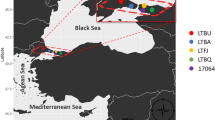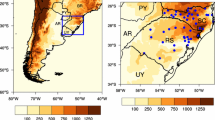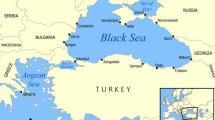Abstract
In this study, snow events in the Marmara region were identified for the 2009–2018 period, and then the times at which a vortex causing the formation of a sea-effect snow (SES) band was seen over the Black Sea were determined from Terra, MSG-2 and MSG-3 satellite imagery. During this period, the SES band was found only between 30 and 31 January 2012 over the western Black Sea. This band maintained its dominance over the region for approximately 24 h. The cause and effects of this band and the precipitation that resulted were investigated. Meteorological data published by 12 airports, 16 meteorological stations and 5 radiosonde stations belonging to five countries were analysed within the two-day period to describe the relevant meteorological conditions. In addition, sea surface temperature data and synoptic charts of the upper atmospheric levels were investigated. According to the results, the maximum amount of snow (24 cm) was observed at the Inebolu Station (in Turkey). As a result of the effect of the vortex-type SES band moving over the Marmara and western Black Sea regions, a total of 102 flights belonging to a private airline company were cancelled, sea transportation was disrupted, and vehicular accidents occurred in Istanbul. In all radiosonde measurements, inversion layers were observed between the surface and the 700 hPa level, and wind direction changes occurred mostly between 0° and 50° within the same level range. The temperature difference between the sea surface and the 850 hPa level reached 25.8 °C where the vortex-type SES band core was located. In the synoptic level charts, the dominance of a low-pressure centre during the two-day period was observed in the area where the vortex-type SES band was formed.

Source Google Earth (2020)

Source NASA (2020)

Source TSMS (2020)



Similar content being viewed by others
References
APDRC (2020) Asia-Pasific Data-Research Center: sea surface temperatures. http://apdrc.soest.hawaii.edu. Accessed 15 August 2020
Asai T, Miura Y (1981) An analytical study of meso-scale vortex-like disturbances observed around Wakasa Bay Area. J Meteor Soc Jpn 59(6):832–843. https://doi.org/10.2151/jmsj1965.59.6_832
Ballentine RJ (1992) Numerical simulation of land-breeze-induced snow bands along the western shore of Lake Michigan. Mon Wea Rev 110:1544–1553
Bolsenga SJ, Norton DC (1992) Maximum snowfall at long-term stations in the U.S./Canadian Great Lakes. Nat Hazards 5:221–232. https://doi.org/10.1007/BF00125228
Burnett AW, Kirby ME, Mullins HT, Patterson WP (2003) Increasing great lake-effect snowfall during the twentieth century: a regional response to global warming. J Clim 16:3535–3542. https://doi.org/10.1175/1520-0442(2003)016%3c3535:IGLSDT%3e2.0.CO;2
Burow D, Atkinson C (2019) An examination of traffic volume during snow events in northeast Ohio. Nat Hazards 99:1179–1189. https://doi.org/10.1007/s11069-019-03786-y
Dunya (2020) Kar çilesi devam edecek. https://www.dunya.com/gundem/kar-cilesi-devam-edecek-haberi-164923. Accessed 6 September 2020 (in Turkish)
Google Earth (2020) https://www.google.com/earth. Accessed 3 September 2020
Efe B, Lupo AR, Deniz A (2019) The relationship between atmospheric blocking and precipitation changes in Turkey between 1977 and 2016. Theor Appl Climatol 138(3–4):1573–1590. https://doi.org/10.1007/s00704-019-02902-z
Efe B, Sezen İ, Lupo AR, Deniz A (2020a) The relationship between atmospheric blocking and temperature anomalies in Turkey between 1977 and 2016. Int J Climatol 40(2):1022–1037. https://doi.org/10.1002/joc.6253
Efe B, Lupo AR, Deniz A (2020b) Extreme temperatures linked to the atmospheric blocking events in Turkey between 1977 and 2016. Nat Hazards 104(2):1879–1898. https://doi.org/10.1007/s11069-020-04252-w
Forbes GS, Lottes WD (1982) Characteristics and evolution of mesoscale cloud vortices occurring in polar airstreams. Preprints Conf Cloud Phys, Chicago, Amer Meteor Soc, pp 310–313
Forbes GS, Merritt JH (1984) Mesoscale vortices over the Great Lakes in wintertime. Mon Wea Rev 112:377–381. https://doi.org/10.1175/1520-0493(1984)112%3C0377:MVOTGL%3E2.0.CO;2
Hjelmfelt MR (1990) Numerical study of the influence of environmental conditions on lake-effect snow-storms on Lake Michigan. Mon Wea Rev 118:138–150. https://doi.org/10.1175/1520-0493(1990)118%3C0138:NSOTIO%3E2.0.CO;2
Hong HP, Ye W (2014) Analysis of extreme ground snow loads for Canada using snow depth records. Nat Hazards 73:355–371. https://doi.org/10.1007/s11069-014-1073-z
IOWA (2020) Environmental Mesonet: ASOS-AWOS-METAR data. https://mesonet.agron.iastate.edu/request/download.phtml. Accessed 19 August 2020
Jiusto JE, Kaplan ML (1972) Snowfall from lake-effect storms. Mon Wea Rev 100:62–66. https://doi.org/10.1175/1520-0493(1972)100%3c0062:SFLS%3e2.3.CO;2
Kelly RD (1986) Mesoscale frequencies and seasonal snowfalls for different types of Lake Michigan snow storms. J Atmos Appl Meteorol 25:308–312. https://doi.org/10.1175/1520-0450(1986)025%3C0308:MFASSF%3E2.0.CO;2
Kindap T (2010) A severe sea-effect snow episode over the city of Istanbul. Nat Hazards 54:707–723. https://doi.org/10.1007/s11069-009-9496-7
Kunkel KE, Wescott NE, Kristovich DAR (2002) Assessment of potential effects of climate change on heavy lake-effect snowstorms near Lake-Erie. J Gt Lakes Res 28:521–536. https://doi.org/10.1016/S0380-1330(02)70603-5
Laird NF (1999) Observation of coexisting mesoscale lake-effect vortices over the western Great Lakes. Mon Wea Rev 127:1137–1141. https://doi.org/10.1175/1520-0493(1999)127%3c1137:OOCMLE%3e2.0.CO;2
Laird NF, Kristovich DAR (2004) Comparison of observations with idealized model results for a method to resolve winter lake-effect mesoscale morphology. Mon Wea Rev 132:1093–1103. https://doi.org/10.1175/1520-0493(2004)132%3C1093:COOWIM%3E2.0.CO;2
Laird NF, Miller LJ, Kristovich DAR (2001) Synthetic dual-Doppler analysis of a winter mesoscale vortex. Mon Wea Rev 129:312–331. https://doi.org/10.1175/1520-0493(2001)129%3c0312:SDDAOA%3e2.0.CO;2
Mahoney EA, Niziol TA (1997) BUFKIT: a software application tool kit for predicting lake-effect snow. Preprints, 13th Int Con on Interactive information and processing systems for meteorology, oceanography, and hydrology, Long Beach, CA, Amer Meteor Soc 388–391
Mesoscale meteorology in mid-latitudes. Wiley-Blackwel, p 407. https://doi.org/10.1002/9780470682104
Meteomanz (2020) SYNOP/BUFR recorded data. http://meteomanz.com/index?l=1. Accessed 19 August 2020
Miyazawa S (1967) On vertical mesoscale disturbances observed during the period of heavy snow or rain in the hokuriku district. J Meteor Soc Jpn 45:166–176
NASA (2020) National Aeronautics and Atmospheric Administration. http://lance-modis.eosdis.nasa.gov/cgi-bin/imagery/realtime.cgi?date=2009058. Accessed 11 September 2020
Niziol TA (1987) Operational forecasting of lake effect snowfall in western and central New York. Weather Forecast 2(4):310–321. https://doi.org/10.1175/1520-0434(1987)002%3C0310:OFOLES%3E2.0.CO;2
Niziol T, Snyder W, Waldstreicher J (1995) Winter weather forecasting throughout the eastern United States. Part IV: lake effect snow. Weather Forecast 10:61–77. https://doi.org/10.1175/1520-0434(1995)010%3c0061:WWFTTE%3e2.0.CO;2
Met Office (2020) Surface pressure charts. https://www.metoffice.gov.uk/weather/maps-and-charts/surface pressure. Accessed 1 September 2020
Özdemir ET, Yetemen Ö (2019) Meteorological analysis of lake enhanced snow in Istanbul, on February 17–19, 2015. J Anatol Env Anim Sci 4(2):115–121 ((in Turkish))
Passarelli RE Jr, Braham RR Jr (1981) The role of the winter land breeze in the formation of Great Lakes snow storms. Bull Amer Meteor Soc 62(4):482–491. https://doi.org/10.1175/1520-0477(1981)062%3c0482:TROTWL%3e2.0.CO;2
Pease RL, Sykes RB Jr (1966) Mesoscale study of a lake effect snowstorm. Mon Wea Rev 94:495–507. https://doi.org/10.1175/1520-0493(1966)094%3C0495:MSOALE%3E2.3.CO;2
Pease SR, Lyons WA, Keen CS, Hjelmfelt M (1988) Mesoscale spiral vortex embedded within a Lake Michigan snow squall band: high resolution satellite observations and numerical model simulations. Mon Wea Rev 116:1374–1380. https://doi.org/10.1175/1520-0493(1988)116%3C1374:MSVEWA%3E2.0.CO;2
PSWC (2020) Plymouth State Weather Center: upper air charts. https://vortex.plymouth.edu/myo/upa. Accessed 18 August 2020
Schmidlin TW (1993) Impacts on severe winter weather during December 1989 in the Lake Erie snow belt. J Clim 6:759–767. https://doi.org/10.1175/1520-0442(1993)006%3C0759:IOSWWD%3E2.0.CO;2
Steenburgh WJ, Halvorson SF, Onton DJ (2000) Climatology of lake-effect snowstorms of the Great Salt Lake. Mon Wea Rev 128:709–727. https://doi.org/10.1175/1520-0493(2000)128%3C0709:COLESO%3E2.0.CO;2
Suriano ZJ, Leathers DJ (2017) Synoptically classified lake-effect snowfall trends to the lee of Lakes Erie and Ontario. Clim Res 74:1–13. https://doi.org/10.3354/cr01480
Trigo IF, Dacamara CC, Viterbo P, Roujean JL, Olesen F, Barroso C, Camacho F, de Coca D, Freitas CSC, Garcia-Haro J, Geiger B, Gellens-Meulenberghs F, Ghilain N, Melia J, Pessenha L, Siljamo N, Arboleda A (2011) The satellite application facility for land surface analysis. Int J Remote Sens 32:2725–2744. https://doi.org/10.1080/01431161003743199
TRT (2020) Karadeniz’de kar hayatı olumsuz etkiledi. https://www.trthaber.com/haber/turkiye/karadenizde-kar-hayati-olumsuz-etkiledi-26534.html. Accessed 5 September 2020 (in Turkish)
TSMS (2020) Turkish State Meteorological Service. http://www.mgm.gov.tr. Accessed 4 September 2020
University of Wyoming (2020) http://weather.uwyo.edu/upperair/sounding.html. Accessed 29 August 2020
Veals PG, Steenburgh WJ (2015) Climatological characteristics and orographic enhancement of lake-effect precipitation east of Lake Ontario and over the Tug Hill Plateau. Mon Wea Rev 143:3591–3609. https://doi.org/10.1175/MWR-D-15-0009.1
Wetter3 (2020) http://www.wetter3.de. Accessed 29 August 2020
Wiedenmann JM, Lupo AR, Mokhov II, Tikhonova EA (2002) The climatology of blocking anticyclones for the Northern and Southern Hemispheres: block intensity as a diagnostic. J Clim 15(23):3459–3473. https://doi.org/10.1175/1520-0442(2002)015%3c3459:TCOBAF%3e2.0.CO;2
Wiggin BL (1950) Great snow of the great lakes. Weatherwise 3:123–126. https://doi.org/10.1080/00431672.1950.9927065
Yavuz V, Deniz A, Özdemir ET, Kolay O, Karan H (2021) Classification and analysis of sea-effect snowbands for Danube Sea area in Black Sea. Int J Climatol. https://doi.org/10.1002/joc.7010
Zhang DL, Fritsch JM (1985) Numerical simulation of a meso-beta scale warm-core vortex over land. Preprints, 14th Conf on Severe Local Storms, Amer Meteor Soc 29–32
Zhao W, Duan SB (2020) Reconstruction of daytime land surface temperatures under cloud-covered conditions using integrated MODIS/Terra land products and MSG geostationary satellite data. Remote Sens Environ 247:1–15. https://doi.org/10.1016/j.rse.2020.111931
Acknowledgements
The authors thank the Turkish State Meteorological Service for providing satellite and meteorological data. The authors also thank Dr. Bahtiyar Efe for his valuable comments. The authors would like to thank the anonymous reviewers and the editor for their contribution to this work.
Funding
The authors did not receive support from any organization for the submitted work.
Author information
Authors and Affiliations
Contributions
The authors have no relevant financial or non-financial interest to disclose.
Corresponding author
Ethics declarations
Conflict of interest
The authors have no conflicts of interest to declare that are relevant to the content of this article.
Additional information
Publisher's Note
Springer Nature remains neutral with regard to jurisdictional claims in published maps and institutional affiliations.
Rights and permissions
About this article
Cite this article
Yavuz, V., Deniz, A. & Özdemir, E.T. Analysis of a vortex causing sea-effect snowfall in the western part of the Black Sea: a case study of events that occurred on 30–31 January 2012. Nat Hazards 108, 819–846 (2021). https://doi.org/10.1007/s11069-021-04707-8
Received:
Accepted:
Published:
Issue Date:
DOI: https://doi.org/10.1007/s11069-021-04707-8










